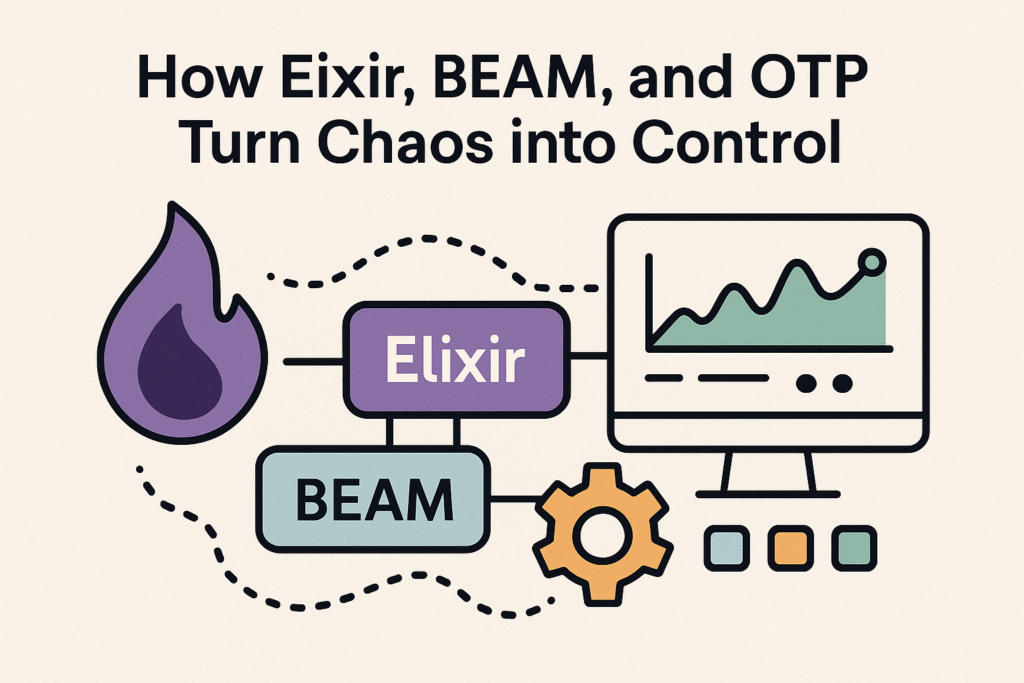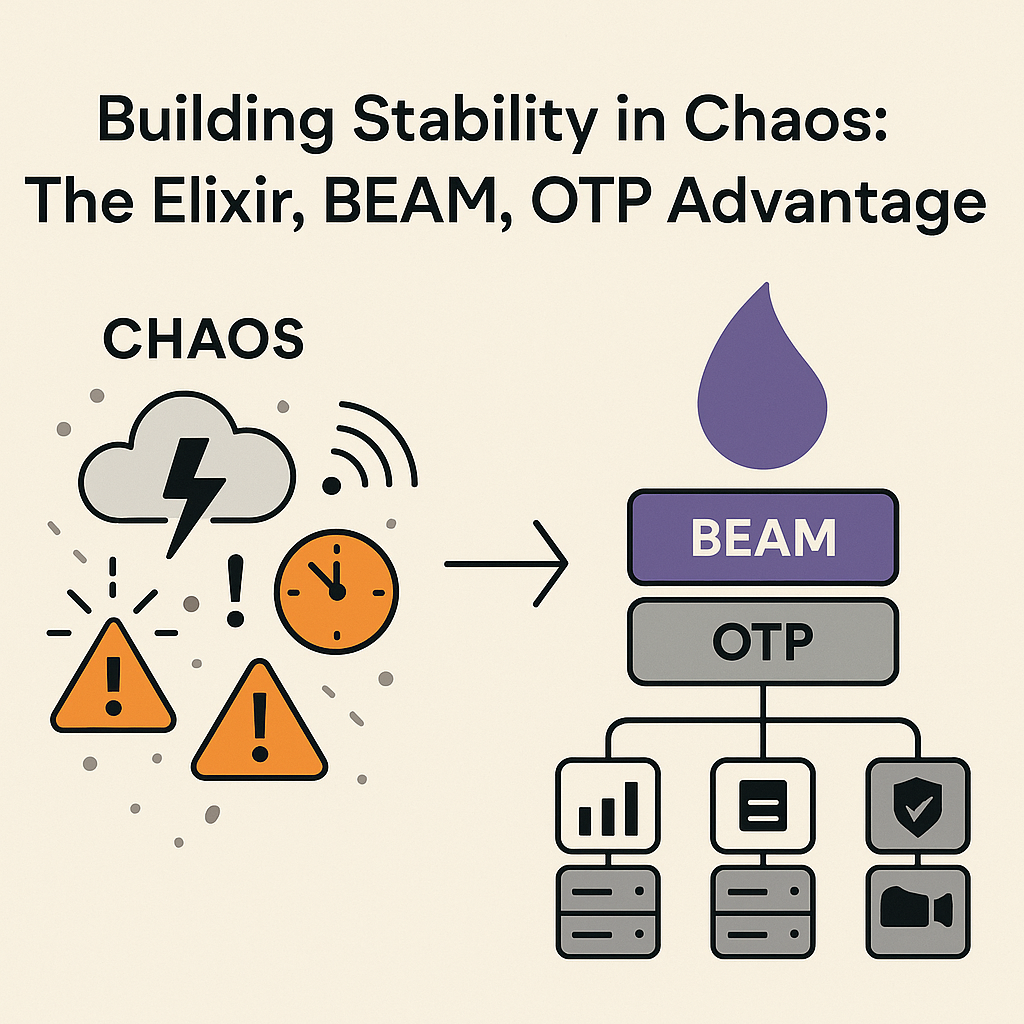In our last post, we explored the chaos that defines modern monitoring systems - real-time alerts, unreliable networks, and the relentless expectation of 24/7 uptime. These are not edge cases; they are the edge. And they expose the limitations of traditional software stacks when faced with the real-time, distributed, fault-prone environments of the modern world.
But what if there was a platform built from the ground up to thrive in this chaos? Welcome to Elixir, powered by the BEAM and OTP - technologies born in telecom, now shaping how resilient, real-time systems are built today.
The Engineering Chaos of Real-Time Systems
Today’s systems are under siege by concurrency, complexity, and failure. Whether you’re managing thousands of distributed sensors, routing alerts from multiple facilities, or powering live dashboards - you’re not managing a simple app anymore. You’re orchestrating a digital city. Each moving part brings risk: slow devices, dropped packets, spikes in traffic, unexpected disconnections. Traditional systems often buckle under this stress - or require expensive and error-prone mitigation layers.
We needed something built for these conditions, not retrofitted for them.
Enter the BEAM: A Virtual Machine Built for Resilience
The BEAM (Bogdan/Björn’s Erlang Abstract Machine) is the virtual machine that powers Elixir. Originally built to support telecom systems that demanded 99.9999999% uptime, the BEAM is battle-tested in the harshest environments.
Unlike traditional VMs like the JVM or Node’s V8, the BEAM doesn’t just support concurrency - it lives and breathes it. Where others rely on threads, async callbacks, or co-routines, the BEAM uses an actor-based concurrency model that spawns lightweight, isolated processes (~1KB each) that communicate via message passing. No shared memory. No locking. No thread contention.
Metaphor: Most systems are cruise ships - one hull, many passengers. If it breaks, everything goes down. The BEAM? It's a fleet of lifeboats. One goes down? The rest keep rowing.
Lightweight Concurrency: The BEAM Scales the Unscalable
Concurrency in the BEAM is cheap and abundant. You can spawn millions of processes, each handling a single responsibility: a device connection, an event processor, a dashboard updater.
This is possible because:
- Each process is fully isolated - no shared state.
- The BEAM schedules them efficiently across CPU cores.
- Crashing one process doesn’t affect the others.
Real-world Example:
A monitoring system handling 10,000 camera streams or 20,000 connected sensors doesn’t need threads, queues, or mutexes. Each stream or sensor can live in its own BEAM process - independently supervised and recoverable.
Compare that to Node.js, where one blocking CPU task can freeze the entire event loop. Or Python, where the GIL restricts true multi-core execution. Elixir’s BEAM thrives on concurrency, and that changes everything.
Fault Tolerance Through OTP: Let It Crash, and Recover Gracefully
If BEAM gives us concurrency, OTP gives us control.
OTP (Open Telecom Platform) is a set of battle-tested frameworks for building fault-tolerant applications. With GenServers, Supervision Trees, and Behaviours, OTP brings structure and predictability to distributed systems.
The “Let It Crash” Philosophy:
In OTP, we expect failure and design the system to recover automatically. If a process crashes - due to a sensor disconnecting or a failed API call - its supervisor restarts it, often within milliseconds. You don’t write try-catch-retry logic. You write systems that self-heal.
Metaphor: OTP is like an air traffic control system that automatically reassigns a new controller when one goes down - without missing a plane.
This model significantly reduces debugging time and makes high-availability systems feasible without fragile workarounds.
Observability and Runtime Introspection
Elixir and the BEAM come with powerful observability features:
- : observer gives a visual UI of process trees, memory usage, and message queues.
- Telemetry allows plug-and-play metrics and tracing.
- Remote shell access (iex --remsh) lets you inspect and modify live systems in production.
These tools make runtime behavior transparent, enabling real-time diagnosis without downtime.
BEAM vs. the World: Why Other Runtimes Struggle
| Feature | Elixir (BEAM) | Go | Node.js | Python |
| Concurrency Model | Actor-based, preemptive | Goroutines, cooperative | Event loop, single-threaded | Threads w/ GIL |
| Fault Tolerance | Built-in via OTP | Manual recovery logic | External libraries | Manual try/catch |
| Hot Code Swapping | Yes | No | No | No |
| Observability | Native tools (observer, telemetry) | Partial | Partial | Weak |
| Real-Time Friendly | ✅ | ⚠️ Somewhat | ⚠️ Event loop-bound | ❌ |
A Glimpse Into TekMedia’s Approach
Without revealing too much (yet), let’s just say these principles - concurrency, fault tolerance, real-time introspection — deeply shaped our architectural decisions. When you’re building systems that monitor thousands of zones, react to intrusions in milliseconds, and maintain reliability across unreliable networks - you don’t want to simulate fault-tolerance, you want it baked in.
As one of our engineers put it: “We needed a system where failure was expected, not feared.”
That mindset led us straight to Elixir.
Conclusion: Turning Chaos into Confidence

The BEAM and OTP are more than just technologies — they’re a philosophy. A way of building systems that embrace the messy reality of modern, distributed computing — and remain stable, scalable, and sane in the face of it.
Elixir inherits this DNA and amplifies it with developer-friendly syntax, powerful tooling, and an ecosystem built for speed and scale. In the next post, we’ll show how TekMedia translated these principles into practice — from real-time dashboards to self-healing alarm pipelines. Stay tuned for an inside look at our architecture, technology decisions, and lessons learned.

